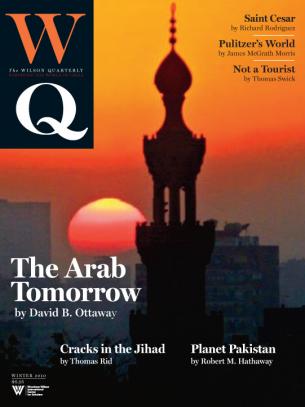The Arab Tomorrow


THE SOURCE: “Against Transparency” by Lawrence Lessig, in The New Republic, Oct. 21, 2009.
THE SOURCE: “District Complexity as an Advantage in Congressional Elections” by Michael J. Ensley, Michael W. Tofias, and Scott de Marchi, in The American Journal of Political Science, Oct. 2009.
THE SOURCE: “Reducing Foreclosures” by Christopher L. Foote, Kristopher S. Gerardi, Lorenz Goette, and Paul S. Willen, in Research Review, Jan.–June 2009.
THE SOURCE: “The Dollar and the Deficits” by C. Fred Bergsten, in Foreign Affairs, Nov.–Dec. 2009.
THE SOURCE: “‘Young Men for War’: The Wide Awakes and Lincoln’s 1860 Presidential Campaign” by Jon Grinspan, in The Journal of American History, Sept. 2009.
THE SOURCE: “The Rise of the Neuronovel” by Marco Roth, in n+1, Fall 2009.
THE SOURCE: “Current Status and Future Prospects of Clinical Psychology: Toward a Scientifically Principled Approach to Mental and Behavioral Health Care” by Timothy B. Baker, Richard M. McFall, and Varda Shoham, in Psychological Science in the Public Interest, Nov. 2008.
THE SOURCE: “Presidential Power Over International Law: Restoring the Balance” by Oona A. Hathaway, in The Yale Law Journal, Nov. 2009.
THE SOURCE: “The Cyberwar Plan” by Shane Harris, in National Journal, Nov. 14, 2009.
THE SOURCE: “Effects of Internet Commerce on Social Trust” by Diana C. Mutz, in Public Opinion Quarterly, Fall 2009.
THE SOURCE: “The Cosmopolitan Tongue: The Universality of English” by John McWhorter, in World Affairs Journal, Fall 2009.
THE SOURCE: “Crime and U.S. Cities: Recent Patterns and Implications” by Ingrid Gould Ellen and Katherine O’Regan, in The Annals of the AmericanThe Annals of the Academy of Political and Social Science, Nov. 2009.
THE SOURCE: “Watchdog or Lapdog? Media Freedom, Regime Type, and Government Respect for Human Rights” by Jenifer Whitten-Woodring, in International Studies Quarterly, Sept. 2009.
THE SOURCE: “Do Television and Radio Destroy Social Capital? Evidence From Indonesian Villages” by Benjamin A. Olken, in American Economic Journal: Applied Economics, Oct. 2009.
THE SOURCE: “The Student of Political Behavior” by Donald Kagan, in The New Criterion, Sept. 2009.
THE SOURCE: “Promises, Promises” by Stuart Blackman, in The Scientist, Nov. 2009.
THE SOURCE: “The Growth of Nuclear Power: Drivers and Constraints” by Richard K. Lester and Robert Rosner, “Nuclear Energy and Climate Change” by Robert H. Socolow and Alexander Glaser, and “Nuclear Power Without Nuclear Proliferation?” by Steven E. Miller and Scott D. Sagan, in Daedalus, Fall 2009.
THE SOURCE: “‘When I Say Get It’: A Brief History of the Boogie” by Burgin Mathews, in Southern Cultures, Fall 2009.
THE SOURCE: “East-Central European Literatures Twenty Years After” by Michael Henry Heim, Peter Sherwood, Kristin Vitalich, et al., in East European Politics and Societies, Fall 2009.
THE SOURCE: “Wink on Pink: Interpreting Japanese Cute as It Grabs the Global Headlines” by Christine R. Yano, in The Journal of Asian Studies, Aug. 2009.
THE SOURCE: “Nunavut at 10,” multiple articles edited by Ailsa Henderson in Journal of Canadian Studies, Spring 2009.
THE SOURCE: “Mobile Phone Diffusion and Corruption in Africa” by Catie Snow Bailard, in Political Communication, July–Sept. 2009.
MEMOIR:
A History.
By Ben Yagoda.
Riverhead. 291 pp. $25.95
THE NEXT HUNDRED MILLION:
America in 2050.
By Joel Kotkin.
Penguin. 320 pp. $25.95
THE FOURTH PART OF THE WORLD:
The Race to the Ends of the Earth, and the Epic Story of the Map That Gave America Its Name.
By Toby Lester.
Free Press. 462 pp. $30
YOURS EVER:
People and Their Letters.
By Thomas Mallon.
Pantheon. 352 pp. $26.95
GREEN METROPOLIS:
Why Living Smaller, Living Closer,and Driving Less Are the Keys to Sustainability.
By David Owen.
Riverhead. 357 pp. $25.95
NOTHING TO ENVY:
Ordinary Lives in North Korea.
By Barbara Demick.
Spiegel & Grau. 314 pp. $24
FIVE TO RULE THEM ALL:
The UN Security Council and the Making of the Modern World.
By David L. Bosco.
Oxford Univ. Press. 310 pp. $24.95
SEARCHING FOR WHITOPIA:
An Improbable Journey to the Heart of White America.
By Rich Benjamin.
Hyperion. 354 pp. $24.99
1688:
The First Modern Revolution.
By Steve Pincus.
Yale Univ. Press. 647 pp. $40
THE PERMISSIVE SOCIETY:
America, 1941–1965.
By Alan Petigny.
Cambridge Univ. Press. 292 pp. $24.99
ABIGAIL ADAMS.
By Woody Holton.
Free Press. 483 pp. $30
COWBOYS FULL:
The Story of Poker.
By James McManus.
Farrar, Straus & Giroux. 516 pp. $30
MUSLIMS IN AMERICA:
A Short History.
By Edward E. Curtis IV.
Oxford Univ. Press. 144 pp. $12.95
The Arab world today is ruled by contradiction. Turmoil and stagnation prevail, as colossal wealth and hypermodern cities collide with mass illiteracy and rage-filled imams. In this new diversity may lie disaster, or the makings of a better Arab future.
In Pakistan, people see Al Qaeda as an imagined threat, and shadowy U.S. agents as the secret power behind major events. How can the United States forge a better partnership with this country that has become the epicenter of global terrorism?
Al Qaeda and the Taliban are at odds, and even Internet jihadis are taking fewer cues from Osama bin Laden. Yet it is only growing more difficult to defeat the global jihad.
Today, as newspapers are shuttered and reporters panhandle for work, it's worth remembering Joseph Pulitzer, whose taste for sensationalism and sense of public service midwifed American journalism into the modern era.
As the leader of the farm workers’ movement, Cesar Chavez became an iconic figure of the 1960s. But his union was largely a failure. It was as a martyr who embodied the psychic contrast between Mexico and America that he commanded our attention.
In the age of Google and YouTube, there's no such thing as terra incognita. But it's still possible to travel to unknown places—with a little imagination.